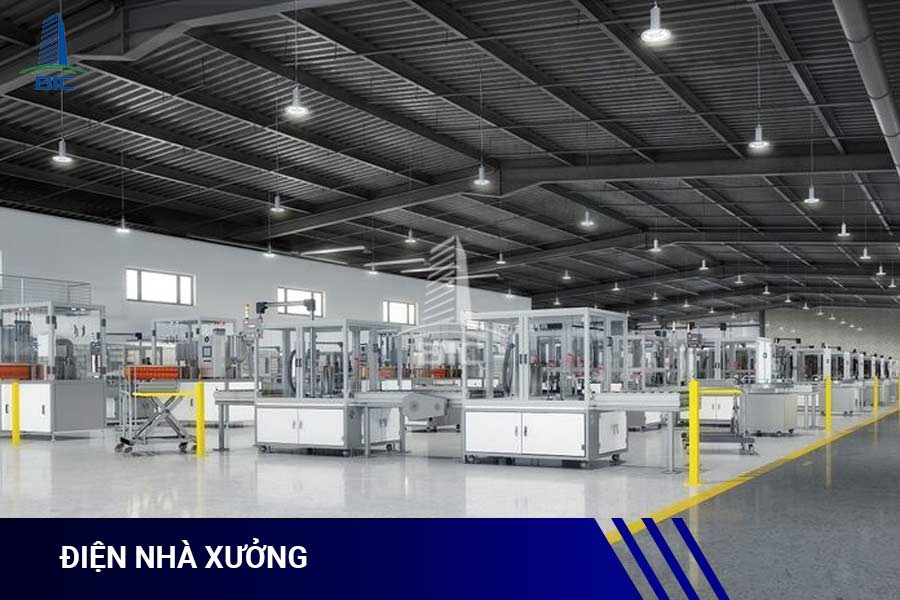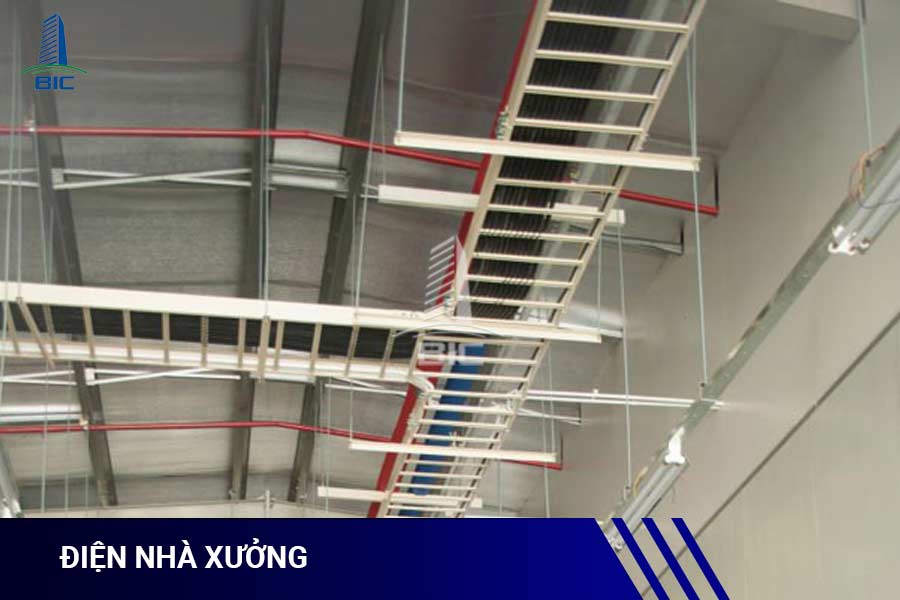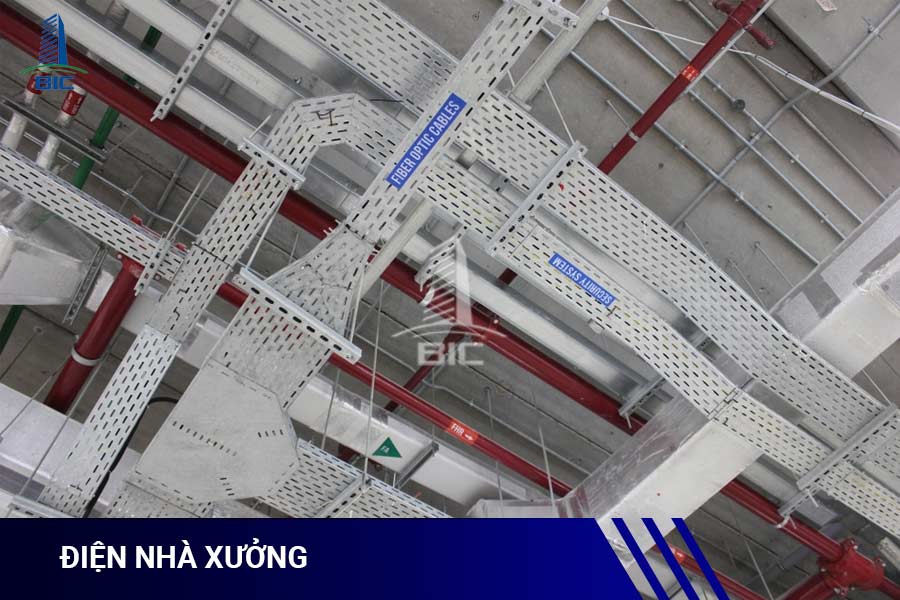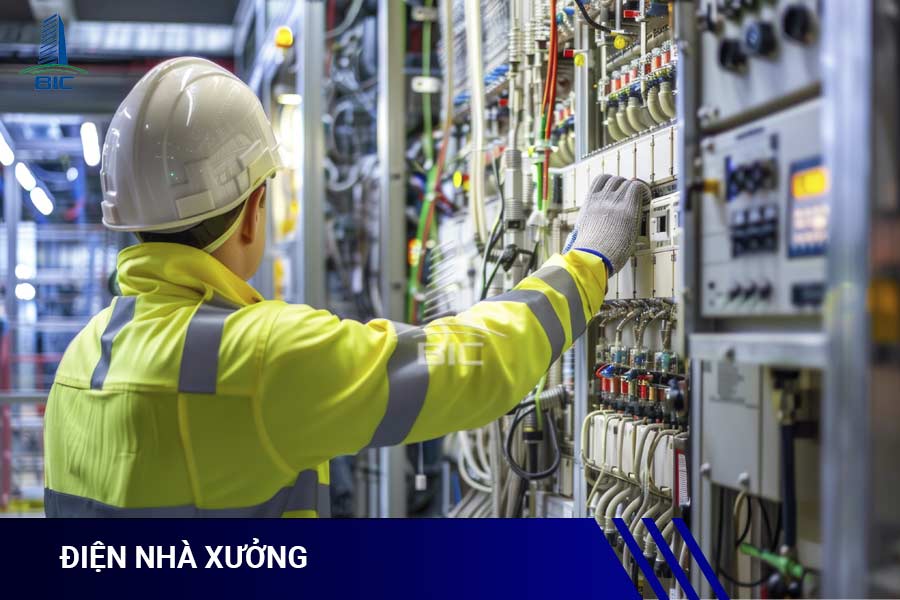
In the process of factory design, the electrical system is always considered a critical component that determines safety, stability, and production efficiency. An optimized electrical design not only ensures sufficient power supply but also helps businesses reduce operating costs, minimize fire and explosion risks, and extend the lifespan of the facility. In reality, many industrial incidents originate from poorly coordinated electrical designs or failure to comply with technical standards, resulting in significant property damage and production disruptions.
Electrical design in a factory requires close coordination with architectural, structural, and other technical systems to create a cohesive whole. Power calculations, load distribution, transformer station placement, electrical panels, lighting, and ventilation solutions must all be planned from the early stages of design and construction. An optimized approach will not only meet current needs but also provide room for future expansion, allowing businesses to proactively plan their production strategies.
With extensive experience in numerous industrial projects, BIC is committed to delivering comprehensive electrical design solutions that strictly comply with current standards and regulations. Each design solution is tailored to the specific production requirements of the business, creating an electrical system that is both safe and energy-efficient while enhancing operational performance and supporting sustainable development.
The electrical system is the backbone of an industrial facility. A well-designed electrical plan not only ensures safety but also determines the stability and efficiency of the entire production process.
First and foremost, the electrical system plays a crucial role in ensuring the safety of workers and machinery. When electrical design is scientifically calculated and adheres to technical standards, the risks of fire, electric leakage, or overload are minimized. This is a vital factor, as even a minor incident can cause significant property damage and disrupt production activities.
Secondly, the electrical system determines the continuity and stability of the production line. Factories often operate multiple high-capacity machines that require a stable and properly distributed power supply. If the electrical design is inadequate, businesses may face voltage fluctuations, load imbalances, or production interruptions, resulting in reduced productivity and higher operating costs.
In addition, an optimized electrical system helps save energy and reduce operating expenses. Proper arrangement of transformer stations, distribution panels, lighting, and ventilation systems not only minimizes power loss but also extends equipment lifespan. In the long term, this is an effective way for businesses to significantly reduce electricity costs, one of the major expenses in industrial production.
Lastly, electrical design directly affects a factory’s ability to expand and grow in the future. A well-planned design anticipates future power needs and includes backup capacity, enabling the facility to upgrade or add new production lines without having to overhaul the entire system. This is an important factor that helps businesses maintain flexibility in an increasingly competitive manufacturing environment.

Designing a factory’s electrical system is not simply about laying cables or installing devices, it’s a process that must follow fundamental principles to ensure safe, stable, and efficient operation. Three key principles form the foundation of any successful project:
Safety is the top priority in all industrial electrical projects. Designs must comply with current Vietnamese standards (TCVN) and may also reference widely recognized international standards. The system must include overload protection, leakage protection, explosion prevention, and proper grounding solutions. This not only protects machinery and equipment but, more importantly, safeguards workers’ lives and minimizes the risk of accidents during production.
An efficient electrical system is designed to distribute power appropriately and meet the specific needs of different areas such as production lines, warehouses, offices, and auxiliary zones. Optimizing functionality not only improves energy efficiency but also reduces power loss during transmission, lowering long-term operating costs. Moreover, a well-organized system simplifies maintenance, load management, and troubleshooting.
In industrial environments, any power outage can result in significant losses. Therefore, electrical design must include backup solutions such as generators and UPS systems for critical areas. The system should also be flexible enough to support future expansion if the business scales up production or installs new machinery. Planning for scalability from the outset helps save on future renovation costs and ensures long-term operational stability.

A factory’s electrical system can only operate safely and reliably if it is designed according to essential requirements, meeting technical standards while aligning with the facility’s production characteristics.
Safety is always the highest priority in factory electrical design. The entire system must comply with national technical standards for industrial electricity, including regulations on wiring installation, grounding, lightning protection, and protective devices. The goal is to minimize fire and explosion risks and ensure the safety of both people and machinery.
Before finalizing a design plan, it is crucial to accurately determine total power requirements and the load for each production line. Load calculations must consider not only current demand but also future expansion potential. Incorrect power assessments can lead to overloads or excessive capacity, resulting in waste and increased operating costs.
Power distribution must be designed scientifically to ensure stable current flow and minimize losses. The selection of transformer stations, main switchboards, distribution panels, and cabling systems must match the factory’s scale. Additionally, the system should be divided into production, storage, and office zones for easier management and maintenance.
Lighting is not only essential for production but also directly affects worker health and productivity. Lighting design must ensure adequate brightness, even distribution, and prioritize energy-efficient solutions such as LED fixtures or natural light panels. Combined with an effective ventilation system, the workspace will remain airy and cool, reducing the load on cooling systems and lowering electricity costs.
A modern factory must have backup power solutions to prevent production disruptions. Generators and UPS systems for critical areas ensure continuous operation during grid failures. Additionally, adopting renewable energy solutions such as rooftop solar panels is becoming a trend, reducing operating costs while contributing to environmental protection.

An effective electrical design goes beyond meeting current needs, it incorporates solutions that ensure safety, efficiency, and flexibility in the long term.
Automation and IoT are revolutionizing power management in factories. Smart control systems can monitor real-time power consumption, detect early signs of overload, and identify abnormal conditions. By integrating sensors and management software, businesses can closely monitor the performance of each production line and make timely adjustments. Automation not only enhances safety but also improves energy efficiency and reduces operating costs.
Electrical design must not be developed in isolation, it should be integrated from the earliest stages of master planning. The electrical system must work seamlessly with the building structure, architecture, fire protection, and other infrastructure systems. This integration ensures smooth construction, prevents conflicts between components, and reduces unforeseen costs. Moreover, early integration simplifies future maintenance and facilitates factory expansion.
Cost-saving does not mean cutting corners on investment but rather choosing sustainable and well-planned design solutions. Using high-quality, certified electrical equipment with long service life reduces maintenance and replacement costs over time. Proper layout of cables, switchboards, and transformer stations not only minimizes power loss but also enhances the stability of the entire production line. With optimized design, factories can achieve maximum operational efficiency at the most reasonable cost.

Implementing electrical design involves more than just drafting drawings, it requires thorough preparation and close coordination to ensure feasibility. The following considerations can help businesses avoid unnecessary risks:
- Assess long-term production needs before design. Many factories struggle with expansion because the original electrical system was sized only for short-term demand. Anticipating load and backup capacity early allows for new production lines or technology upgrades without major system overhauls.
- Prioritize the quality of electrical materials and equipment. Using substandard equipment may reduce initial costs but increases risks such as frequent breakdowns, overloads, or safety hazards. Choosing certified industrial-grade equipment from reputable manufacturers ensures stable operation and reduces maintenance costs.
- Design for scalability and ease of maintenance. Electrical cabinets, wiring, and distribution systems should be arranged logically to allow engineers to perform regular inspections, maintenance, or troubleshooting easily. This not only shortens downtime during incidents but also ensures continuous production.
- Ensure coordination during implementation. Close collaboration among the design team, contractors, and operations department helps identify and correct design issues promptly, avoiding additional costs and delays.
Electrical design for factories requires in-depth technical knowledge, safety expertise, and an understanding of legal regulations. Not all businesses have the internal capacity to handle this comprehensively. Partnering with a professional design and construction firm offers significant advantages:
Experienced firms analyze the actual needs of the business to propose optimized solutions for power capacity, distribution, and lighting. More importantly, design documents are prepared in compliance with TCVN standards and international codes, giving businesses confidence when submitting documents for approval and construction permits.
When the design is accurately calculated from the outset, businesses can avoid additional costs for modifications during construction. Proper equipment selection and system layout also help save energy and lower long-term operating costs.
The electrical system is directly tied to many legal requirements such as fire safety, environmental regulations, and occupational safety. Professional firms are experienced in working with regulatory authorities and can assist businesses in preparing complete documentation, reducing the risk of rejections or approval delays.
A professional design and construction firm doesn’t just deliver drawings, they can also collaborate with contractors throughout the construction process. They ensure installation follows the design, maintain quality standards, and help the business bring the factory into operation on schedule.
Electrical design is a critical component that determines the safety, stability, and operational efficiency of an entire factory. A well-planned electrical system not only meets current production needs but also supports future expansion, helping businesses save costs and strengthen their competitive edge.
With extensive experience in industrial projects, BIC provides optimal factory and electrical design solutions that fully comply with technical standards and legal requirements. By partnering with BIC, businesses can confidently build safe, sustainable facilities that are ready for long-term growth.